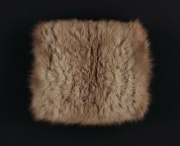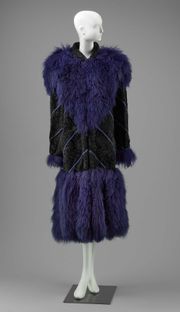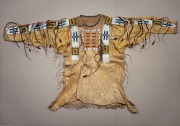Difference between revisions of "Fur"
| Line 4: | Line 4: | ||
The fine soft hair or the hair-covered pelt of a non-human mammal. Fur can consist of one or two layers: [[underfur]] and [[guard hair|guard hairs]]. The bottom layer, or underfur consists of short, soft, dense and often curly hairs. In some animals, the underfur is the only hair layer, such as in [[wool]]. In other animals,Some animals also have an unpper protective layer of guard hairs. The stiff long guard hairs stick out through the underfur and provide pigmentation and extra protection. Furs from some animals, such as [[sable]], [[ermine]], [[mink]], [[raccoon]], [[otter]], [[skunk hair|skunk]], [[beaver]], [[sealskin|seal]], and [[blue fox|fox]], have been used to make, trim and line garments. Fur provides excellent insulation because of its ability to trap a layer of air among the fine hairs. The most prized furs come from animals in cold latitudes obtained during the winter season when the pelt is the fullest. Often furs on the market have been clipped and dyed to imitate other types of animals. A dyed fur is not as durable as a natural fur because the acids and mordants can weaken the skin and make it brittle. Starting in 1952 in the U.S., fur garments were required to have labels accurately labeling their species name and country of origin. Additionally, Canada, Russia, and most of the EU also require labeling of furs. | The fine soft hair or the hair-covered pelt of a non-human mammal. Fur can consist of one or two layers: [[underfur]] and [[guard hair|guard hairs]]. The bottom layer, or underfur consists of short, soft, dense and often curly hairs. In some animals, the underfur is the only hair layer, such as in [[wool]]. In other animals,Some animals also have an unpper protective layer of guard hairs. The stiff long guard hairs stick out through the underfur and provide pigmentation and extra protection. Furs from some animals, such as [[sable]], [[ermine]], [[mink]], [[raccoon]], [[otter]], [[skunk hair|skunk]], [[beaver]], [[sealskin|seal]], and [[blue fox|fox]], have been used to make, trim and line garments. Fur provides excellent insulation because of its ability to trap a layer of air among the fine hairs. The most prized furs come from animals in cold latitudes obtained during the winter season when the pelt is the fullest. Often furs on the market have been clipped and dyed to imitate other types of animals. A dyed fur is not as durable as a natural fur because the acids and mordants can weaken the skin and make it brittle. Starting in 1952 in the U.S., fur garments were required to have labels accurately labeling their species name and country of origin. Additionally, Canada, Russia, and most of the EU also require labeling of furs. | ||
| − | [[File:1991.962-SC83947.jpg|thumb|]] | + | [[File:1991.962-SC83947.jpg|thumb|Lakota shirt <br>MFA# 1991.962]] |
== Synonyms and Related Terms == | == Synonyms and Related Terms == | ||
Revision as of 14:43, 3 September 2020
Description
The fine soft hair or the hair-covered pelt of a non-human mammal. Fur can consist of one or two layers: Underfur and guard hairs. The bottom layer, or underfur consists of short, soft, dense and often curly hairs. In some animals, the underfur is the only hair layer, such as in Wool. In other animals,Some animals also have an unpper protective layer of guard hairs. The stiff long guard hairs stick out through the underfur and provide pigmentation and extra protection. Furs from some animals, such as Sable, Ermine, Mink, Raccoon, Otter, skunk, Beaver, seal, and fox, have been used to make, trim and line garments. Fur provides excellent insulation because of its ability to trap a layer of air among the fine hairs. The most prized furs come from animals in cold latitudes obtained during the winter season when the pelt is the fullest. Often furs on the market have been clipped and dyed to imitate other types of animals. A dyed fur is not as durable as a natural fur because the acids and mordants can weaken the skin and make it brittle. Starting in 1952 in the U.S., fur garments were required to have labels accurately labeling their species name and country of origin. Additionally, Canada, Russia, and most of the EU also require labeling of furs.
Synonyms and Related Terms
pelt; animal skin; pelage; pels (Dan.); Fell (Deut.); fourrure (Fr.); bont (Ned.); futro (Pol.); päls (Sven.); piel (Esp.); pele, pele com pêlo (Port.)
Risks
Moisture decreases softness and flexibility.
Furs are susceptible to moths.
Resources and Citations
- Edward Reich, Carlton J. Siegler, Consumer Goods: How to Know and Use Them, American Book Company, New York City, 1937
- Italian Fur Trade Federation: www.iftf.com/labelling.asp
- Wikipedia: http://en.wikipedia.org/wiki/Fur (Accessed Nov. 2, 2005)
- Van Nostrand's Scientific Encyclopedia, Douglas M. Considine (ed.), Van Nostrand Reinhold, New York, 1976
- Random House, Webster's Encyclopedic Unabridged Dictionary of the English Language, Grammercy Book, New York, 1997
- The American Heritage Dictionary or Encarta, via Microsoft Bookshelf 98, Microsoft Corp., 1998


